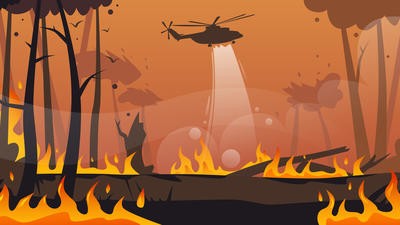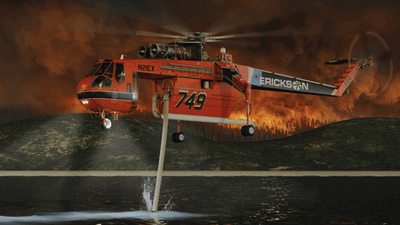Aerial Firefighting in South America

Mandy Langfield takes a look at aerial firefighting in the region of South America, considering how operators have adapted to key environmental and cultural factors
When the Amazon rainforest was burning in 2019, an area of the world that doesn’t usually see a great deal of global media attention suddenly had the world looking in. Efforts to control the blaze were monumental, and involved military and civilian assets from all over the world. The aerial firefighting infrastructure in Latin America was thrown into sharp relief, and attention was paid by the global community to what national governments were doing to fight the fires, both from the ground and in the air.
Whether the Amazonian forest fires of 2019 were a natural catastrophe as a result of climate change or were deliberately incited by those with a vested interest in clearing areas of forest for farming purposes are not the subject of this article. Either way, the problem was of a scale not seen for many years, and it has the potential to worsen year after year as pressure grows on natural resources.
The current state of aerial firefighting assets varies from country to country in South America; in many nations, the government has moved to adapt its Air Force assets so that they can become part of an aerial firefighting fleet. Brazil, for instance, modified its C-130 Hercules aircraft into water bombers, and tens of thousands of military personnel were deployed to the Amazon in an effort to combat the fires in 2019. Offers of international aid by governments were received with a mixed response – a political tussle between French President Emmanuel Macron and Brazilian leader Jair Bolsonaro made the headlines for days. Brazil did, however, accept help from Israeli authorities, which deployed an aircraft and team of specialized firefighting experts to help.
Bolivia, by contrast, welcomed aid from international sources. In Uruguay, the Air Force can modify its aging fleet of UH-1H into aerial firefighting units, while in Chile, military P-295 aircraft act as lead planes for DC-10s from US-based 10 Tanker deployed during the summer months.
Coulson Aviation has been working in aerial fire suppression in South America for many years, with operations in Chile and, more recently, in Bolivia. “Our fleet of C130s, 737s, Ch-47D, S-61s and Black Hawk helicopters is now at a point where we can serve a whole country’s aerial firefighting needs, rather than just one region,” explained Foster Coulson of Coulson Aviation. “With more diverse aircraft comes increased abilities to scan the fire lines for hotspots and direct the water bomber aircraft to the exact spot that is necessary to be most effective in suppressing the fire.”
South American politics and cultural expectations are different to those in other parts of the world, and once you win a contract with a government or other agency locally, it is vital that you not until meet you obligations, but you actually exceed expectations, said Coulson. The company’s experience of working with the Bolivian government, he added, was wholly positive. There was almost constant ongoing contact with not only the federal authorities, but the president himself.
“Admittedly,” added Coulson with a wry note, “occasionally their reaction time in certain situations could have been improved upon, but their commitment to letting us do our jobs was faultless.” Initially, the Bolivian contract was just for three helicopters, but it quickly became apparent to the Coulson team that the operational management of the fire suppression resources needed some assistance. In the end, the company deployed a significant number of its own operational team members to Bolivia to oversee the management of the whole operation, which allowed the team to be more effective in deploying local resources to the right place, at the right time.

Colombia is also a nation that relies on its military to provide aerial firefighting services. Air Force C-130H have been adapted to enable the use of Modular Airborne FireFighting Systems (MAFFS) to help firefighters do their jobs on the ground more effectively. March 2020 saw the deployment of US Air Force personnel to Colombia as part of a training team to assist Colombian forces deploy the technology. “While a very effective firefighting tool, this specific mission set requires consistent practice,” said US Air Force Lt. Col. Richard Pantusa, 731st Airlift Squadron MAFFS Instructor Pilot from Peterson Air Force Base, Colorado. “It is inherently a dangerous mission – flying low over mountainous terrain that is on fire. The FAC (Fuerza Area Columbiana – Colombian Air Force) has a new MAFFS program that includes highly motivated and knowledgeable C-130 operators who are attempting to grow their MAFFS program.”
February 2017 saw the introduction of private aerial firefighting services in Ecuador with an Agusta A109K2. Since then, over 100 lives have been saved, whether the aircraft was used for aerial firefighting, or search and rescue missions. La Dirección de Operaciones Aéreas del Cuerpo de Bomberos del Distrito Metropolitano de Quito (CBDMQ) has been so successful in its mission profile that it has actually gained the respect of the civil aviation authority in the country and is now recognized as a public service. Equipped with a Bambi Bucket, the crew have been tasked with 448 firefighting missions since it started operating, as well as 43 flights transporting firefighters to forest fires.

More intense fire season in 2020 due to deforestation?
Cause and effect
Ane Alencar, Director of Science at the Amazon Environmental Research Institute (IPAM), said in an interview with National Geographic in 2019: “The majority of the fires we’re seeing now are because of deforestation. It’s crazy. We reduced deforestation by almost 65 per cent in the past. We proved that we could do that. And now we’re going backwards.” Farmers and ranchers keen to clear land quickly to start monetizing it see burning as the most effective way to achieve their goal, but controlling such burns is obviously difficult, resulting in wildfires that quickly consumes huge hectares of precious Amazon forest.
IPAM Amazonia, the Amazon Environmental Research Institute, raised concerns that deforestation in 2020 – in addition to the vegetation that was felled in 2019 and now needs to be burned – could fuel a more intense fire season in the Amazon this year. “When the dry season arrives in the Amazon, these felled trees will become fuel for burning. This was the main ingredient of the 2019 fire season, a story that can repeat itself in 2020 if nothing is done to prevent it,” explained Ane Alencar, Director of Science at IPAM. A technical note from IPAM released in April found that drought alone does not explain the scale of the fires last year, despite governmental sources suggesting it, but that instead, an acute element of the increase in fire activity was deforestation. Alencar commented: “The Amazon is a humid forest and does not naturally catch fire. The fire has a culprit, and mankind is responsible.”

Chile
Erickson Incorporated, a leading aerospace manufacturer and global aerial services company that has fought fires for nearly 50 years, has been operating aerial firefighting services in Chile in the Bío Bío Region since 2017. The aircraft, an S-64 Aircrane, was brought in by Ecocopter – a Latin American national company of high complexity air services and cargo transport – to provide services to the company ARAUCO, with the aim of protecting population and industrial centers. The S-64 Helitanker is equipped with a 10,000 liter tank capable of snorkeling via a ‘sea snorkel’ fresh or salt water that helps provide an outstanding capability for fire authorities in both the initial attack of fast moving fires and advanced structure protection. It has internal foam mixing capabilities and provides water or retardant dispensation utilizing eight coverage levels. The aircraft can be configured with a water cannon for high-rise and structure protection.
A study by the National Forest Corporation or CONAF (Corporación Nacional Forestal) found the S-64 Aircrane was chosen as the most efficient aircraft for Chilean firefighting. CONAF is a Chilean private, non-profit organization, through which the Chilean state contributes to the development and sustainable management of the country’s forest resources. CONAF is overseen and funded by Chile’s Ministry of Agriculture. There is no one governmental agency that has the authority, responsibility, and resources to manage wildfires in the Country.
Andrew Mills, Erickson President of Commercial Aviation, said at the time: “We appreciate the trust of our agency partners and customers and will endeavor to do our best for the people of Chile. Erickson has nearly 50 years of legacy experience in aerial firefighting and we are proud to bring our capable pilots, crews and ‘Annie’ back to help mitigate fire damage.”
Chile also relies on other providers for its aerial firefighting services; Jan 2019 saw one of 10 Tanker Air Carrier’s DC-10 very large air tankers deployed to the country. John Gould, President of 10 Tanker, said it will be working for CONAF.
Eve Billings Flying Service has also been contracted by one of the largest pulp and paper companies in Latin America to provide aerial fire suppression services in Chile using one of its CH-47D Chinooks. Billings became the first non-military owner of CH-47D Chinook helicopters when they purchased their first two in 2014.

Coulson’s operations in Chile are now so ubiquitous that the company has actually created a joint venture with equipment manufacturer PESCO in order to operate more effectively and be on the ground more readily with its resources. One of the things that Foster Coulson is passionate about is meeting – and exceeding – the needs of the clients, and that operators be tasked with being efficient and effective. After all, there’s no point sending massive water bombers to drop their load but due to a lack of technology and ability, the water ends up half a mile away from the fire.
“I believe that as a company, you should be judged on the cost per gallon delivered on target,” he told AirMed&Rescue. “The level of accountability has to increase, and technology is key to achieving this.” With Coulson Aviation’s CH-47D helicopters carrying 3,000 gallons of water per trip (bearing in mind the C-130 and 737 can carry 4,000 gallons), this makes the Chinooks remarkably cost efficient on a per-trip basis.
More space in the market
There is no doubt that the market for aerial firefighting in South America is hotting up (pun intended). Sikorsky and United Rotorcraft tried to enter market with regional tour in 2018 to sell the Firehawk solution: The Blackhawk Firehawk Aerial Firefighting Mission Package consists of a 3,785-liter (1,000-gallon) water tank with a retractable snorkel attached to the belly of the aircraft, and an extended main landing gear. Colombia operates the region’s largest fleet of Black Hawk helicopters, with almost 100 acquired since 1988. Argentina, Brazil and Chile collectively operate another 22 Black Hawk aircraft, so certainly the opportunity to increase market share for companies that can modify existing aircraft into firefighting assets are in a strong position.
For those companies deploying new and innovative aerial firefighting technology, whether that is updated aircraft or more sophisticated fire detection hardware and software to enable accurate water drops, the market in South America certainly has the potential to change a company’s fortunes. Meeting the needs of customers will be key to lasting relationships and ongoing operations in this vast continent, with challenging terrain, weather and politics.
Sources:
- Fireaviation.com
- Sikorsky.com
- CoulsonUnical.com

